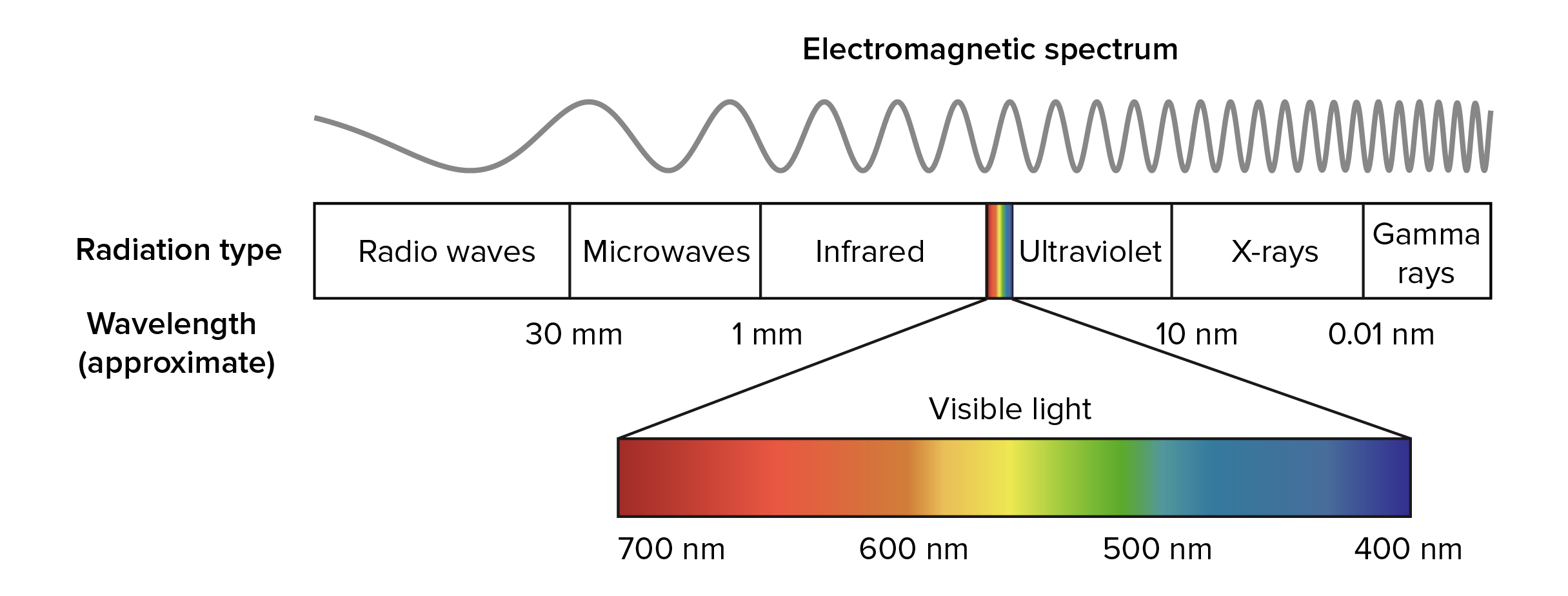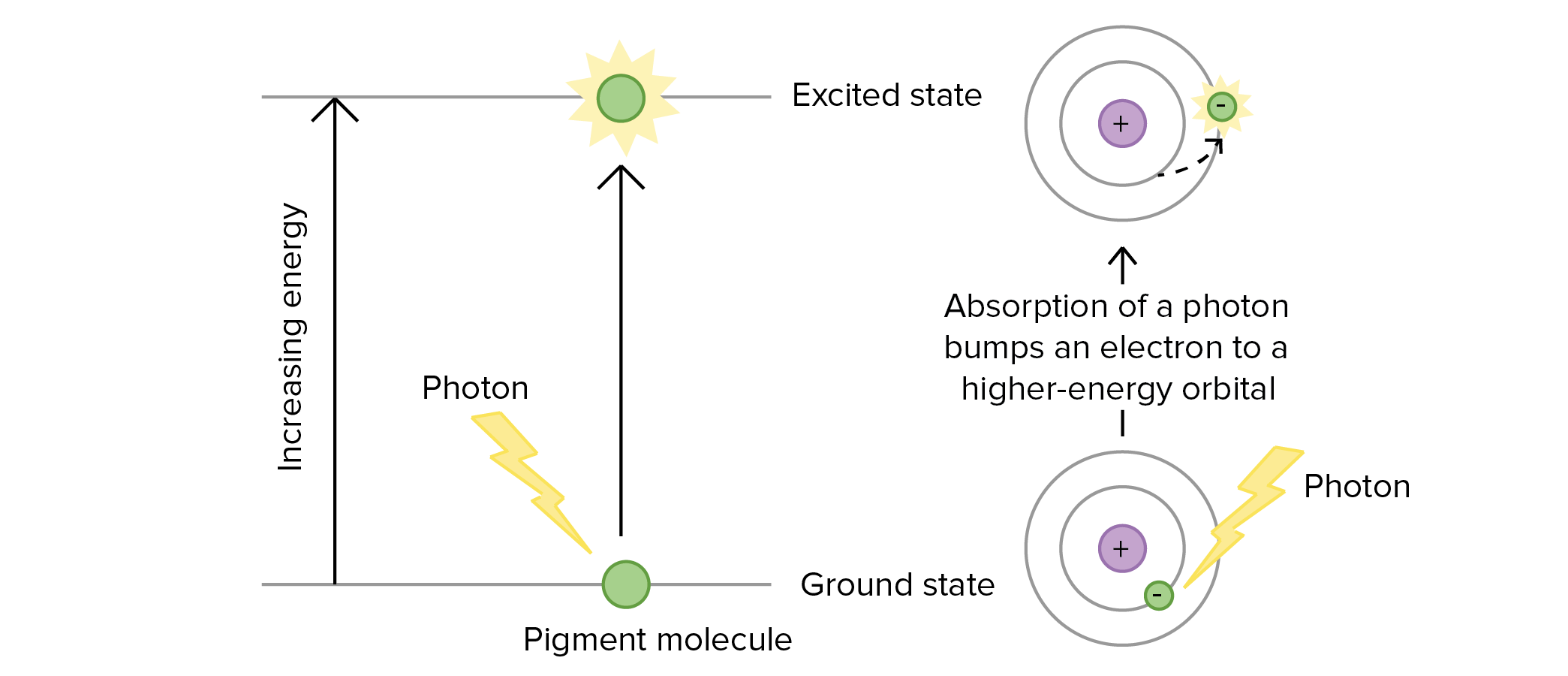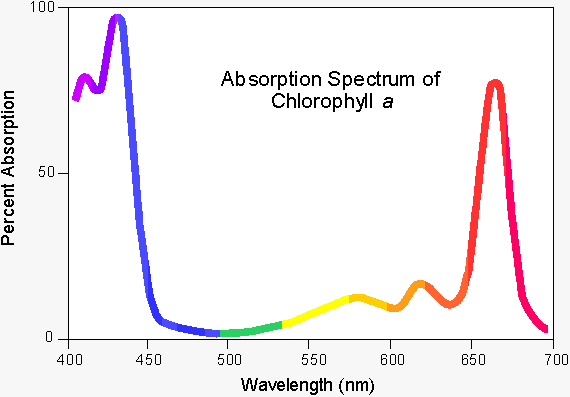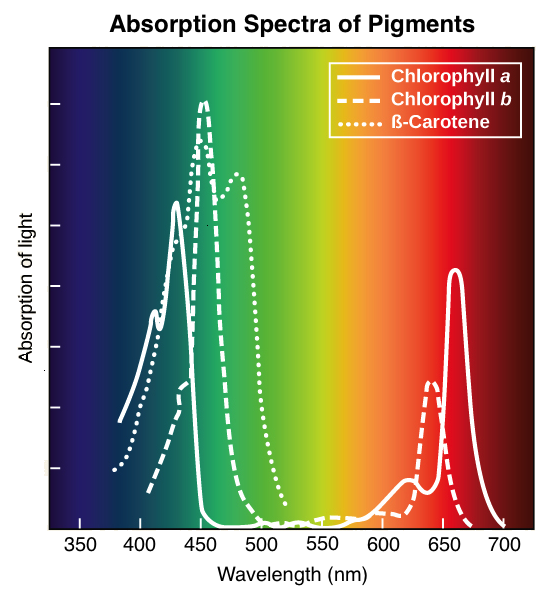Chlorophyll a green pigment found in chloroplasts is an important part of the light-dependent reactions. The combination of reduced light lack of nutrients and less water triggers the trees to start the process of breaking down the chlorophyll and the green color fades.

Understanding Photosynthesis How Does Chlorophyll Absorb Light Energy

Wavelengths Of Light And Photosynthetic Pigments Article Khan Academy

Chlorophyll A B And Carotenoids Absorbance Spectra Download Scientific Diagram
Chlorophyll also chlorophyl is any of several related green pigments found in the mesosomes of cyanobacteria and in the chloroplasts of algae and plants.
What light does chlorophyll a absorb. The reason that light intensity does affect the rate of photosynthesis is because as light and therefore energy falls on the chloroplasts in a leaf it is trapped by the chlorophyll which then makes the energy available for chemical reactions in the plant. One way to get liquid chlorophyll in your diet is by juicing and drinking wheatgrass and other dark leafy greens. The chlorophyll absorbs energy from the light waves which is converted into chemical energy in the form of the molecules ATP and NADPH.
These two types are efficient in absorbing the light and are effective photoreceptors. This molecule is used in photosynthesis as a photoreceptor 20. Since violet wavelengths have the most energy in the visible light range due to their shorter wavelengths they can provide the maximum energy for photosynthesis.
Chlorophyll a is a specific form of chlorophyll used in oxygenic photosynthesisIt absorbs most energy from wavelengths of violet-blue and orange-red light and it is a poor absorber of green and near-green portions of the spectrum. This lower chlorophyll absorption rate compared to blue and red light is what makes most plants appear green. It is also the reason why plants are green.
If you look at a spectrum from 400nm-. Through photosynthesis the plant uses the stored energy to convert carbon dioxide absorbed from the air and water into glucose a type of sugar. Several modifications of chlorophyll occur among plants and other photosynthetic organisms.
Chlorophyll A and chlorophyll B. Its name is derived from the Greek words χλωρός khloros pale green and φύλλον phyllon leaf. Chlorophyll a and b together absorb light most effectively in the blue to violet range and the orange to red range.
Meanwhile the carotenoids are absorbing maximally at those wavelengths where chlorophyll does poorly light blue to green. Chlorophyll can be further be divided in two main groups. Carbon dioxide water and light are all needed for photosynthesis to take place.
This mean it will absorb any wavelength of light which is not in the green spectrum of light. Chlorophyll is essential in photosynthesis allowing plants to absorb energy from light. Chlorophyll is a color pigment found in plants algae and phytoplankton.
Chlorophylls role is to absorb light for photosynthesis. Plants need water carbon dioxide and light for photosynthesis. The most important part of chlorophyll is to absorb and transfer the light to the dedicated reaction centers in each photosystem.
Chlorophyll does not reflect light but chlorophyll-containing tissues appear green because green light diffusively reflected by structures like cell walls. As a food coloring chlorophyll is used to add a green color to pasta the spirit absinthe and other foods and beverages. Photosynthesis definition the complex process by which carbon dioxide water and certain inorganic salts are converted into carbohydrates by green plants algae and certain bacteria using energy from the sun and chlorophyll.
Because the green color was masking other color pigments we start to see the yellows. Once that light energy is absorbed the carotenoids pass that energy on to a neighboring chlorophyll molecule. Nitrogen is part of the chlorophyll molecule which gives plants their green color and is involved in creating food for the plant through photosynthesis.
Chlorophylls job in a plant is to absorb lightusually sunlight. Carotenoids assist with photosynthesis by absorbing wavelengths of light that chlorophylls cannot absorb. All photosynthetic organisms plants certain protistans prochlorobacteria and cyanobacteria have chlorophyll a.
Chlorophyll As central role is as an electron donor in the electron transport chain. You may remember that colors are different wavelengths of light. There are two main types of chlorophyll.
As most parts of plants are already green due to the presence of chlorophyll green lights are least absorbed by plants and thus are one of the least effective for plant growth. The diagrams in this lesson show how photosynthesis works. The light-independent stage also known as the Calvin Cycle takes place in the stroma the space between the thylakoid membranes and the chloroplast membranes and does not require light hence the name light- independent reaction.
Carotenoids Absorb In Wavelengths that Chlorophyll Does Poorly In. Another way is to consume liquid chlorophyll as a supplement. Liquid chlorophyll is an extraction of the pigment chlorophyll found in plants.
Since chlorophyll does not absorb green light as readily as other wavelengths many have written off the green waveband as being less important to plant growth. Chlorophyll soaks up the energy from sunlight. According to the diagram how does the plant absorb water for photosynthesis.
During this time of year chlorophyll breaks down so the carotenoid pigments become visible. Photosynthesis is a chemical reaction that takes place inside a plant producing food for the plant to survive. Chlorophyll captures red and blue wavelengths of light and reflects the green.
The energy absorbed from light is transferred to two kinds of energy-storing molecules. To absorb the light the plants use chlorophyll the pigment that makes leaves green. Chlorophyll is a complex molecule.
Verb to take in something such as water in a natural or gradual way. Accessory photosynthetic pigments including chlorophyll b and beta-carotene absorb energy that chlorophyll a does not absorb. Photoreceptors absorb light energy and chlorophyll specifically absorbs energy from sunlight 15.
To take in knowledge attitudes etc. Because nitrogen can move around in the plant older growth often yellows more than the new growth. Chlorophyll Bs role is to help organisms absorb higher frequency blue light for use in photosynthesis.
While plants do absorb a limited amount of green light they are not big fans of it. They transfer energy to chlorophyll molecules and also help to protect the leaf from excess light they absorb surplus light energy and dissipate it as heat to prevent it from damaging the leaf. Light is an extremely important factor for the process.
Chlorophyll only triggers a chemical reaction when it is associated with proteins embedded in a membrane such as in thylakoid membranes of the chloroplast or membrane infoldings found in photosynthetic prokaryotes. Photosynthesis needs water carbon dioxide chlorophyll light and the right temperature. Chlorophyll is an essential pigment molecule for photosynthesis the chemical process plants use to absorb and use energy from lightIts also used as a food coloring E140 and as a deodorizing agent.
Lack of nitrogen shows up as general yellowing chlorosis of the plant.
The Light Dependent Reactions Of Photosynthesis Boundless Biology

Wavelengths Of Light And Photosynthetic Pigments Article Khan Academy
What Is The Absorption Spectrum Of Chlorophyll A And The Action Spectrum Of Photosynthesis Quora
What Wavelengths Of Light Does Chlorophyll A Absorb Best

Pigment Extraction Lab Theory
1

Structure And Reactions Of Chlorophyll

Wavelengths Of Light And Photosynthetic Pigments Article Khan Academy
